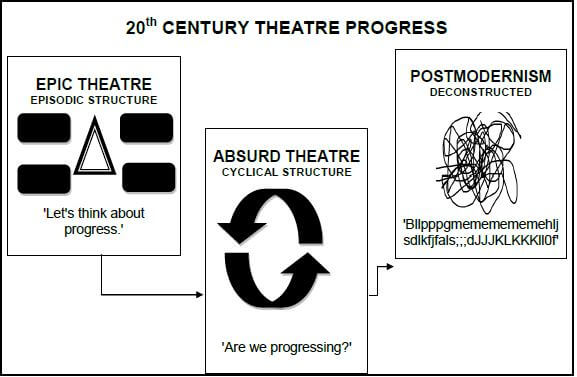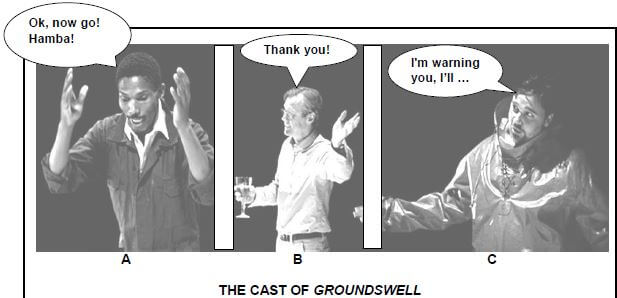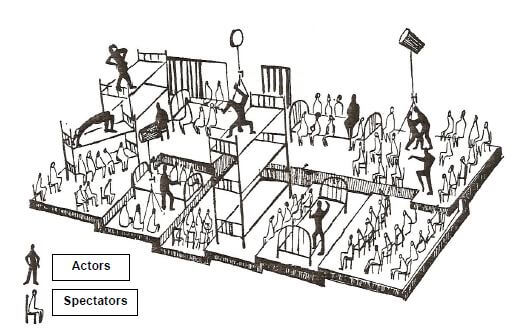DRAMATIC ARTS GRADE 12 QUESTIONS - NSC PAST PAPERS AND MEMOS FEBRUARY/MARCH 2018
Share via Whatsapp Join our WhatsApp Group Join our Telegram GroupDRAMATIC ARTS
GRADE 12
NSC PAST PAPERS AND MEMOS
FEBRUARY/MARCH 2018
INSTRUCTIONS AND INFORMATION
- This question paper consists of FOUR sections:
SECTION A: 20th Century Theatre Movements (30)
SECTION B: South African Theatre: 1960–1994 (40)
SECTION C: South African Theatre: Post-1994 – Contemporary (40)
SECTION D: The History of Theatre, Practical Concepts, Content and Skills (40) - SECTION A
QUESTION 1 is COMPULSORY.
Refer to the play text you have studied and the relevant 20th Century Theatre Movement.
EPIC THEATRE- Caucasian Chalk Circle Bertolt Brecht
- Kaukasiese Krytsirkel Translation of Bertolt Brecht play text
- Mother Courage Bertolt Brecht
- Moeder Courage Translation of Bertolt Brecht play text
- The Good Person of Szechwan Bertolt Brecht
- Kanna Hy Kô Hystoe Adam Small
OR- THEATRE OF THE ABSURD
- Waiting for Godot Samuel Beckett
- Afspraak met Godot Translation of Samuel Beckett play text
- Bagasie André P Brink
- The Bald Primadonna Eugene Ionesco
- Die Kaalkop Primadonna Translation of Eugene Ionesco play text
OR- POSTMODERN THEATRE
- Skrapnel Willem Anker
- Top Girls Carol Churchill
- Popcorn Ben Elton
- Buried Child Sam Shepard
- SECTION B
This section consists of THREE questions. Answer only ONE question in this section.
QUESTION 2: Woza Albert! Percy Mtwa, Mbongeni Ngema and Barney Simon OR
QUESTION 3: Sophiatown Junction Avenue Theatre Company OR
QUESTION 4: Siener in die Suburbs PG du Plessis - SECTION C
This section consists of THREE questions. Answer only ONE question in this section.
QUESTION 5: Nothing but the Truth John Kani OR
QUESTION 6: Groundswell Ian Bruce OR
QUESTION 7: Missing Reza de Wet - SECTION D
This section is COMPULSORY. Answer QUESTIONS 8 AND 9.
QUESTION 8: Theatre history, Practical concepts, Content and Skills
QUESTION 9: Theatre history, Practical concepts, Content and Skills
QUESTIONS
SECTION A: 20th CENTURY THEATRE MOVEMENTS
This section is COMPULSORY.
QUESTION 1
Study SOURCE A below and answer the question that follows.
SOURCE A 
Evaluate how the diagram of any ONE of the 20th Century Theatre Movements in SOURCE A reflects the subject matter, socio-political context and plot structure of the play text you have studied. Create an original argument, in the form of an evaluative essay, which refers to the question, the diagram you have chosen, the play text you studied and its associated Theatre Movement (Theatre of the Absurd or Epic Theatre or Postmodern Theatre).
Indicate the title of the play text you have studied at the top of your essay.
TOTAL SECTION A: 30
SECTION B: SOUTH AFRICAN THEATRE: 1960–1994
Answer only ONE question in this section.
QUESTION 2: WOZA ALBERT! BY PERCY MTWA, MBONGENI NGEMA AND BARNEY SIMON
Study SOURCE B below and answer the questions that follow.
SOURCE B
BWW Review: Will the real Woza Albert! please stand up? About ten years ago, I saw a production of Woza Albert! that added pre-recorded music to an already uninspired reading of Mbongeni Ngema, Percy Mtwa and Barney Simon's anti-apartheid play. The music neither elevated (raised the standard of) that production nor illuminated (clarified) the text. By David Fick |
2.1 Identify the 'Albert' referred to in the title and state what he represents. (2)
2.2 Explain, with examples, how Mbongeni Ngema and Percy Mtwa created the music in the original production of Woza Albert!, through their use of vocal and physical skills. (4)
2.3 Analyse why the use of 'pre-recorded music' (lines 1–2) may change the impact of a production of Woza Albert!. (3)
2.4 Motivate why the play, Woza Albert!, may still be a success even 'more than three decades after its premiere' (line 5). (4)
2.5 You are responsible for directing a scene in Woza Albert! using a genre that is different from Poor Theatre.
2.5.1 Name the genre you will use to direct your scene. (1)
2.5.2 Describe the scene you have selected. (2)
2.5.3 Explain how you could stage the scene to reflect the characteristics of the genre you selected in QUESTION 2.5.2. (6)
2.6 Analyse why the final scene of Woza Albert! is a 'thrilling conclusion' (line 12) to the play and has the ability 'to inspire solidarity (unity) and action' (line 15). (6)
2.7 Evaluate whether the 'sociopolitical and economic situation' (line 6) portrayed in Woza Albert! is still relevant to South Africa today.
Your evaluation should include THREE specific examples from the play text and TWO examples of current events. (12) [40]
QUESTION 3: SOPHIATOWN BY THE JUNCTION AVENUE THEATRE COMPANY
Study SOURCE C below and answer the questions that follow.
SOURCE C
EXTRACT FROM SOPHIATOWN Koloi e, ha ena marili (x2) This car, this car MINGUS: It dances 'Chips' (x2) 10 |
3.1 Refer to SOURCE C.
3.1.1 Describe the mood created by the song and the effect it may have on the audience. (2)
3.1.2 Motivate what the car in the song might symbolise. (4)
3.1.3 Explain the purpose of the song as a theatrical device in this scene. (2)
3.1.4 Suggest why the creators of Sophiatown chose to use a variety of languages in the play. (4)
3.1.5 Motivate how you would stage SOURCE C in order to communicate the message of this scene. (6)
3.1.6 Discuss the vocal and physical skills required by the actors in order to perform this scene effectively. (6)
SOURCE D
The main conflict in Sophiatown is that of the individual against societal forces. Society's rules or laws prevent the characters from reaching their own goals. In Sophiatown, the societal power is the apartheid government, which enforced racial segregation. This is also the underlying cause of the various occurrences of interpersonal conflict in the play and the internal conflict within each of the characters. 5 [Source: Sophiatown, 2015 Edition] |
3.2 Refer to SOURCE D.
3.2.1 Explain any TWO of 'society's laws' which prevented the characters in Sophiatown from 'reaching their own goals' (line 2). (4)
3.2.2 Evaluate how the many conflicts between the characters reflect the mood and messages of Sophiatown.
Substantiate your answer by referring to the following:
- Interpersonal conflict (conflict between characters)
- Internal conflict (conflict within a character)
- Decisions made by the characters and the resulting actions, behaviour and consequences (12) [40]
QUESTION 4: SIENER IN DIE SUBURBS BY PG DU PLESSIS
Study SOURCE E below and answer the questions that follow.
SOURCE E
PLAYWRIGHT'S DIRECTIONS FOR THE SETTING OF THE PLAY Dis Vrydagaand en somer en nog lig in die suidelike voorstede van Johannesburg. Ons kyk na die agterplaas van Ma se semi en sien: |
Refer to SOURCE E and then imagine that you are the director of a new production of Siener in die Suburbs. You are being interviewed by the media before the opening night of the play. They ask you the following questions:
4.1 Name the setting (time AND place) of the play. (2)
4.2 Name the type of dramatic structure used by the playwright of Siener in die Suburbs. (1)
4.3 Suggest how the time of the action is a reflection of the realistic nature of the play. (2)
4.4 Give a brief character sketch of Ma which will be included in the programme notes of the play. (3)
4.5 Describe, with reasons, the choice of costume that you have selected for the actor playing the role of Ma in your production. (4)
4.6 Name and describe the vocal and physical skills an actor would require to portray the role of Ma effectively. (6)
4.7 Discuss the significance of the 'enkelgarage' (line 3) to the action in the play. (6)
4.8 Suggest what might be the dramatic value of including 'AT YOUR OWN RISK' (line 7), painted red, on the set of the play. (4)
SOURCE F
A REVIEW OF SIENER IN DIE SUBURBS ON GOODREADS.COM PG du Plessis's play was lauded (celebrated) when first performed and published. After more than 40 years the characters, conflict and dialogue retain power – in the hands of an excellent cast it will still have an audience spellbound. [Source: http://www.goodreads.com/book/show/1231642.Siener_in_die_suburbs] |
4.9 Refer to SOURCE F.
'After more than 40 years the characters, conflict and dialogue still 'retain power' (line 2).
Evaluate the validity (truth) of the statement above. You must refer to the following in your discussion:
- Characters
- Conflict
- Dialogue
- Relevance to society today (12) [40]
TOTAL SECTION B: 40
SECTION C: SOUTH AFRICAN THEATRE: POST-1994 – CONTEMPORARY
Answer only ONE question in this section.
QUESTION 5: NOTHING BUT THE TRUTH BY JOHN KANI
Study SOURCE G below and answer the questions that follow.
SOURCE G
EXTRACT FROM NOTHING BUT THE TRUTH SIPHO enters the kitchen unnoticed … MANDISA: Come with me to London. We will go together to the London Fashion Week. My father always said he wished you could come to London. |
5.1 Describe how the actor playing Sipho could 'enter(s) the kitchen unnoticed' (line 1). (2)
5.2 Explain how Sipho's entrance could add to the dramatic tension of this scene. (3)
5.3 Refer to Thando's words in line 4.
5.3.1 Suggest why Thando is 'so excited and confused at the same time'. (2)
5.3.2 Analyse how the actor playing Thando could reflect that she is 'excited and confused at the same time' through her vocal and physical skills. (4)
5.3.3 Motivate why Mpho's opinion is so important to Thando. (3)
5.4 Discuss the reasons for the conflict between Mandisa and Sipho. (4)
5.5 Refer to Sipho's words in line 14.
5.5.1 Explain why Sipho makes this statement by referring to TWO examples in the play as to why he feels this way. (6)
5.5.2 Describe the tone of voice the actor playing Sipho could use to emphasise his feelings in this scene (2)
5.6 Explain why the audience might find line 15 humorous in the context of the play as a whole. (4)
5.7 Realistic drama is real life portrayed on stage.
Evaluate how Nothing But The Truth is 'real life portrayed on stage'.
In your discussion refer to the following:
- Language
- Characters
- Staging (10) [40]
QUESTION 6: GROUNDSWELL BY IAN BRUCE
Study SOURCES H and I below and answer the questions that follow.
SOURCE H 
6.1 Identify the genre of the play Groundswell. (1)
6.2 Name the characters marked A, B and C in SOURCE H. Write only the letter and the name next to the question number (6.2). (3)
6.3 Explain how the costume of each actor in SOURCE H reflects his character and situation. (6)
6.4 Motivate how each actor's posture and dialogue is suitable for the character he is playing (SOURCE H). (6)
6.5 The characters in Groundswell are complex individuals, driven by their personal desires and dreams. This is why tension between the characters exists.
Discuss this statement by referring to how the characters add to the dramatic tension in Groundswell. (6)
SOURCE I
'The play is gender biased!' [Source: @theatre4UsAll] |
6.6 After watching a recent production of Groundswell, you are required to respond to the accusations and criticisms of the tweet in SOURCE I to defend the universal nature of the play.
6.6.1 Argue against the statement: 'The play is gender biased.' (4)
6.6.2 Comment on the personal bias of the tweet to show how we can be influenced by social media. (4)
6.6.3 Evaluate why everyone would benefit from studying and watching this play.
In your discussion refer to the following:
- Characters
- Themes of belonging and identity (10) [40]
QUESTION 7: MISSING BY REZA DE WET
Study SOURCE J and answer the questions that follow.
SOURCE J
AN ADVERT FOR A 2010 PRODUCTION OF MISSING Missing It is 31 August. The wind is howling around the corners of a derelict little house. From afar the sound of circus music is audible. Around the kitchen table, three women, each trying to calm her own fears. Will a girl again go missing in her snow white confirmation dress this year, like previous years? The women are anxious – but believe that the minister/pastor and elders, who are praying the whole evening, will avert the evil. 5 Suddenly there is a knock at the door. It is an unfamiliar, blind constable who claims that he has come to keep an eye on them … Will the constable be able to protect them from the dangers of the night? [Source: http://argief.litnet.co.za/article.php?news_id=87848] |
Your Dramatic Arts teacher presents you with the advertisement above to use as inspiration when you direct your own production of Missing at your school.
7.1 Explain the significance of the following in the play:
7.1.1 '31 August' (line 1) (1)
7.1.2 'The wind is howling' (line 1) (1)
7.1.3 'circus music' (line 2) (2)
7.2 Suggest the symbolic significance of Reza de Wet's choice of colour for the 'confirmation dress' (lines 3–4). (2)
7.3 Analyse how the advertisement creates a mysterious mood. (SOURCE J) (4)
7.4 Evaluate whether you think the inclusion of the picture used in the advertisement for the play is appropriate. (SOURCE J) (4)
7.5 Describe the type of stage you would choose for your own production of Missing. Refer to the GENRE as well as TECHNICAL considerations with regard to the play. (6)
7.6 Name any TWO props you wish to include in the play in order to highlight the themes of the play. Motivate why you want to include the props named. (4)
7.7 The advertisement refers to the 'blind constable' (line 6). (SOURCE J) Explain the significance of blindness as a motif (image) in the play as a whole. (6)
7.8 Write to your school principal to motivate why Missing is an excellent choice of play to be staged at your school.
Include the following in your discussion:
- Knowledge of Dramatic Arts skills
- Analysis of the play text (genre, characters, themes and relevance)
- Budget and staging (10) [40]
TOTAL SECTION C: 40
SECTION D: THE HISTORY OF THEATRE, PRACTICAL CONCEPTS, CONTENT AND SKILLS
This section is COMPULSORY. Answer QUESTIONS 8 AND 9.
QUESTION 8
Study SOURCE K below and answer the questions that follow.
SOURCE K 
8.1 Identify the parts of the stage labelled A and B. (2)
8.2 Give TWO possible theatrical uses for the ladders in SOURCE K. (4)
8.3 Discuss how the staging in SOURCE K could reflect any ONE 20th century movement (-ism) you studied this year. (4)
SOURCE L
|
8.4 Describe Grotowski's use of space in Kordian in SOURCE L. (4)
8.5 Identify and explain any TWO of Grotowski's principles of acting. (6)
8.6 Analyse the staging challenges that Grotowski might have faced when directing this production. (4)
8.7 Explain the impact this kind of theatrical production might have had on the audience members watching the play.
Refer to the following:
- Staging
- Setting of the play (4) [28]
QUESTION 9
Study the source below and answer the questions that follow.
SOURCE M
One of the aims of the National Curriculum is to … promote human rights, inclusivity, environmental and social justice. |
Apply your knowledge of dramatic processes, principles and skills and discuss how Dramatic Arts promotes the aims of the National Curriculum in SOURCE M.
Refer to the following:
- Play texts you have studied and lessons learnt
- Perfomances you have seen and their impact
- Productions in which you have participated and how you developed [12]
TOTAL SECTION D: 40
GRAND TOTAL: 150
